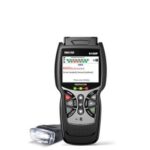Experiencing car troubles after recent repairs can be frustrating. You’ve just picked up your vehicle from the dealer after addressing evap system codes P0445 and P0446, only to encounter a new issue and the OBD2 code P1295. This situation, where your car starts but idles roughly and doesn’t respond to the gas pedal, followed by the check engine light illuminating with code P1295, can be concerning. Let’s delve into what this code signifies and potential causes.
Understanding OBD2 Code P1295
OBD2 code P1295 is generally defined as a “Fuel Pump Relay Circuit Malfunction.” This indicates a problem within the electrical circuit that controls your vehicle’s fuel pump relay. The fuel pump relay is a critical component in your car’s fuel delivery system. It acts as a switch, providing power to the fuel pump when the engine needs fuel. When the engine control module (ECM) detects an issue within this circuit, such as a short, open, or high/low voltage, it triggers the P1295 code and activates the check engine light.
Symptoms Associated with P1295
The symptoms you experienced, including rough idling, lack of response from the gas pedal, and engine stalling shortly after starting, are consistent with a fuel delivery problem often linked to the P1295 code. These symptoms arise because if the fuel pump relay circuit is malfunctioning, the fuel pump may not be receiving consistent or adequate power. This can lead to:
- Rough idling: Inconsistent fuel supply causes uneven combustion, resulting in a rough idle.
- Engine stalling: If the fuel pump is intermittently losing power, the engine may stall, especially at low speeds or idle.
- Lack of throttle response: Without sufficient fuel pressure, the engine cannot respond when you press the gas pedal, leading to a lack of acceleration.
- Check Engine Light: The ECM detects the circuit malfunction and illuminates the check engine light, storing the P1295 code.
Potential Causes of OBD2 Code P1295
Several factors can contribute to a P1295 code. While your dealer suggested weather conditions, it’s less likely to be the primary cause, though humidity could potentially affect electrical connections. More probable causes include:
- Faulty Fuel Pump Relay: The relay itself might be failing internally, causing intermittent or complete circuit breaks.
- Wiring Issues: Problems in the wiring harness related to the fuel pump relay circuit, such as corrosion, damaged wires, or loose connections, can disrupt the electrical flow.
- ECM Malfunction: In rarer cases, a fault within the ECM itself could lead to misdiagnosis of the fuel pump relay circuit.
- Fuel Pump Issues: Although the code points to the relay circuit, problems with the fuel pump drawing excessive current could also trigger the code in some instances.
Diagnosing and Addressing P1295
When faced with a P1295 code, a systematic diagnostic approach is essential. Here are steps that a mechanic would typically undertake:
- Code Verification: Confirm the presence of the P1295 code using an OBD2 scanner.
- Relay Inspection: Check the fuel pump relay for any signs of damage or corrosion. Testing the relay’s functionality using a multimeter is crucial.
- Circuit Testing: Thoroughly inspect the wiring and connectors in the fuel pump relay circuit for continuity, shorts, and proper voltage.
- ECM Examination: If wiring and relay are ruled out, the ECM might be considered as a potential issue, although ECM problems are less common.
Given that the issue temporarily resolved itself after restarting the engine, it could indicate an intermittent electrical fault, possibly related to a relay or wiring connection. While the dealer might dismiss it initially, persistent P1295 codes and drivability issues warrant further investigation. It’s advisable to monitor if the problem recurs and, if it does, bring your vehicle back to a trusted mechanic or the dealer for a more in-depth diagnosis of the fuel pump relay circuit. Providing them with the specific OBD2 code P1295 and the symptoms you experienced will aid in their troubleshooting process.
